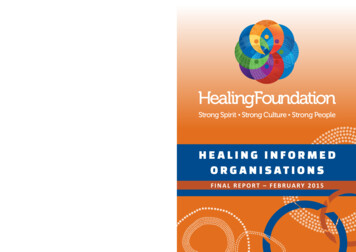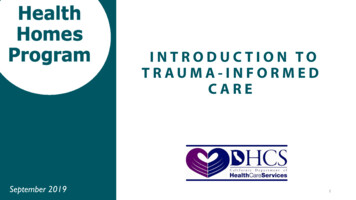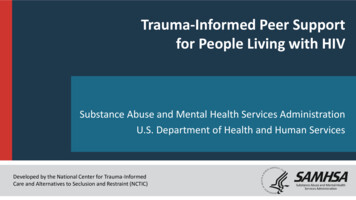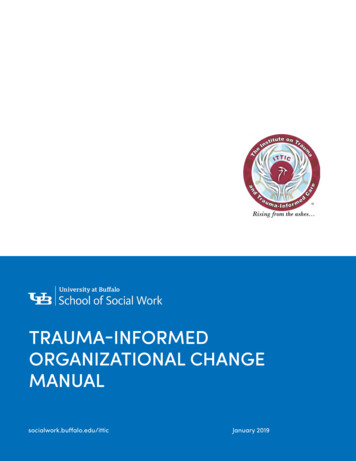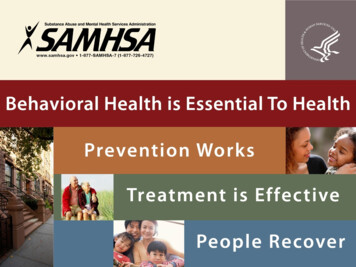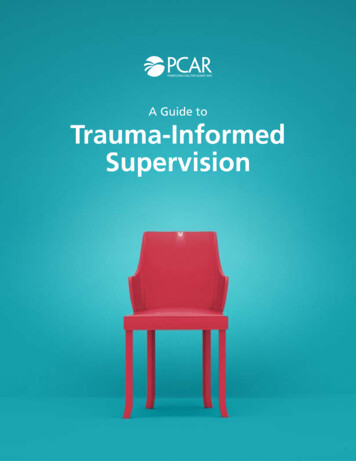
Transcription
A Guide toTrauma-InformedSupervision
AknowledgementsWe thank the following professionals who dedicated theirtime and expertise in contribution of this document:Eric Stiles, M.S.Claudia J. Dewane, LCSW, DEd, BCDMaryClaire Mullen, MSW, LSWAli Mailen Perrotto, M.A.Rick Azzaro, MSW, LCSW, PhDPCAR Trauma-Informed Supervision GuidePage 2
Helping the Helpers:Trauma-Informed Supervision atVictim Service ProvidersAdvocates at victim service providers have dedicated themselves to working with survivors of trauma. Anadvocate sits with a person as they explore their experience of trauma and healing. The very role of an advocateis to spend some quality time with another person’s trauma.Survivors beneft from working with a caring, compassionate, and informed helper to assist in their healingjourney. They need someone who knows the systems and resources available. They deserve a person who canbe fully present in the face of what is often a dark and secret trauma (VanDernoot-Lipsky & Burk, 2007). To haveadvocates like this, victim service providers need to focus on helping the helpers.Working with trauma can affect advocates in many ways. Sometimes they are so focused on a survivor’s healingjourney, they neglect their own well-being. They may not feel worthy of help, thinking attention on themselvessomehow takes away from the survivors. With many victim service providers underfunded and advocatesoverworked, there may be little time for an advocate to focus on themselves. This is why organizations musttake responsibility for encouraging organizational trauma prevention and vicarious trauma prevention.Contrary to historical models of defcit-based supervision which focuses on identifying and rectifying problemareas (Edwards & Chen, 1999), trauma-informed supervision is an effective tool that supports advocates,provides opportunities for learning, and can prevent further trauma from occurring. Advocates, at all levels, eventhose who have been in the movement for many years, can beneft from such supervision. Including supervisionas a normal work routine can make it a tool to increase knowledge and skills, more effectively help survivors,and improve employee wellness and morale.Through research and practical application, the Pennsylvania Coalition Against Rape has determined thateffective supervision occurs in a trauma-informed environment. Organizations must acknowledge the traumathat advocates may bring to their work, and the additional trauma they acquire by working with victims ofsexual abuse and misconduct. Organizations must give permission for advocates to also focus on their ownhealing processes. Organizations can break down prior stigmas about supervision by normalizing it, and byclearly explaining its purpose(s) and beneft(s).This guide was developed to aid supervisors of advocates at victim service providers. The purpose is to provide abrief overview and best practices for organizations to create an environment for effective supervision.It addresses the following topics: Defning Trauma Importance of Supervision Navigating Vicarious Trauma Defning Supervision Providing Effective Supervision Supervision Considerations Trauma-informed Organizations Supervisor’s Toolbox forOrganizationsPCAR Trauma-Informed Supervision GuidePage 3
Defning TraumaTrauma, adversity, and chronic stress are universal to the human experience and affect individuals, communities,and organizations (Walsh, 2017). Trauma is a result of an event, a series of events, or circumstances that anindividual experiences as physically or emotionally harmful or life threatening. It causes lasting effects on aperson’s functioning and well-being. What is traumatic for one individual may not be for another. How a personexperiences the event may depend on their cultural beliefs, availability of social supports, or their developmentalstage. The effects of trauma may happen immediately, gradually, or may show up years later (SAMHSA, 2014).Adverse Childhood ExperiencesAdverse Childhood Experiences (ACEs) is a term used to describe the types of traumatic experiences that occurto people under the age of 18, including (but not limited to) neglect, abuse, and/or household dysfunction.ACEs have been linked to risky health behaviors, chronic health conditions, low life potential, and early death(CDC, 2019). A personal ACEs inventory can help someone understand their own health and life challenges,which can provide insight into wellness and healing strategies (Walsh, 2017). This is usually an activityperformed during an advocate’s required sexual assault counselor training program.Trauma Past, Present, and FutureTrauma changes over time. New traumas can occur and the impact of past traumas can intensify or lessen(SAMHSA, 2014). Advocates with unresolved trauma are more likely to experience triggers, so the organizationshould have systems in place to help protect them from exposure to potential triggers and to help them copewhen triggers do occur. It is likely that despite safeguards put in place, new traumas will occur, such as illness,fnancial woes, etc. Support systems can help staff members deal with uprising trauma. In addition to newtrauma, becoming a parent or grandparent can change one’s perspective of their work, and organizationsshould be aware of this possibility for staff (Washington Coalition of Sexual Assault Programs [WCSAP], 2012).Trauma-Informed ApproachA trauma-informed approach not only utilizes trauma-specifc interventions, but it also incorporates key traumaprinciples into the organizational culture. Using a trauma-informed approach means the organization realizesthe widespread impact of trauma and recognizes the signs and symptoms as they can show up in clients,advocates, and other staff. The organization understands the potential paths of recovery, and therefore respondsby fully integrating knowledge about trauma into its practices and policies in order to resist re-traumatization(SAMHSA, 2014).PCAR Trauma-Informed Supervision GuidePage 4
According to the Substance Abuse and Mental Health Services Administration, there are six key principles of atrauma-informed approach:SafetyStaff and clients feel physically and psychologically safe, including the physical setting and interpersonalinteractions.Trustworthiness & TransparencyOrganizational decisions are made with transparency with the goal of building and maintaining trust amongclients and staff.Peer SupportMutual self-help and support among peers helps to establish safety, hope, trust, collaboration, and promoterecovery and healing.Collaboration & MutualityImportance is placed on partnership and dismantling power differences, both among staff and with clients. Theorganization values that everyone has a role to play in a trauma-informed approach.Empowerment, Voice, and ChoiceClient and staff strengths and experiences are recognized and built upon. Individuals are supported in shareddecision making and goal setting to make choices that are best for them and their healing.Cultural, Historical, and Gender IssuesThe organization recognizes and addresses historical trauma and works to move past cultural stereotypes andbiases. Gender, racial, ethnic, and cultural needs of clients and staff are met (SAMHSA, 2014).Learn more about how to make your organization more trauma-informed on page 19.Using a trauma-informed approach means theorganization realizes the widespread impact of traumaand recognizes the signs and symptoms as they canshow up in clients, advocates, and other staff.PCAR Trauma-Informed Supervision Guide”Page 5
Defning SupervisionThe ultimate goal of supervision is to help workers provide clients with the best possible services (Edwards &Chen, 1999). To accomplish this goal, supervisors provide a combination of administration, education, andsupport (Tsui, 2005). Supervision is typically viewed as a partnership between a supervisor and supervisee.Supervision is not something that is done to a person, but is done with a person. It requires active participationfrom both the supervisor and supervisee. Supervision creates the space to discuss how an advocate’s role ftswith the mission of the center, explores training needs, and provides ongoing support to avoid the negativeimpacts of vicarious trauma.Functions of SupervisionEvery supervisory check-in may not cover all three functions (administrative, educational, and supportive), but itis important for the advocate to be able to examine each area at some point in the supervisory process.Administrative supervisionRequires the supervisor to provide supervisees with the structure and resources needed to do their jobs well.There is a focus on productivity, workload, job performance, and quality of service (Association for AdvancedTraining, n.d.; Tsui, 2005). There should be discussion of current cases and projects, as well as policies andprocedures of the organization. Administrative supervision may also connect to the center’s strategic planor goals.Educational supervisionHelps an advocate to develop skills and knowledge, and grow as a professional. Supervisors should provideadvocates with strategies and skills needed to do their job well, and provide opportunities for developingexpertise in related areas that interest them. Supervisors should use their experience to give advice, guidance,and feedback that will help the advocate develop professionally (Tsui, 2005). This is also an opportunity torefresh or enhance skills and strategies learned in initial advocacy training, or to learn new information that maybe useful in their role. As the supervisory relationship progresses, the supervisor and advocate will learn fromone another, and the supervisor may become a consultant rather than a teacher or mentor (Association forAdvanced Training, n.d.).Supportive supervisionAims to reduce job-related stress and provide the advocate with resources for their emotional health. It alsoaims to increase an advocate’s motivation, satisfaction, and commitment to their job (Association for AdvancedTraining, n.d.). Supervisors should recognize an advocate’s achievements, show their appreciation for theindividual, and validate their feelings (Tsui, 2005).PCAR Trauma-Informed Supervision GuidePage 6
Trauma & SupervisionA trauma lens informs our understanding of supervision in several ways. Supervision should be structuredin a way for staff to gain support, debrief about their work, and advance their skills and knowledge. Whenoperating from a trauma lens, supervisors should also support professional growth and encourage learningopportunities. It is crucial for organizations to create safe spaces for meaningful and sometimes diffcultconversations, and to mitigate the impacts of vicarious trauma (Walsh, 2017).What Supervision is NotSupervision is not therapyIt’s important for supervisors to set boundaries around discussion of advocate’s personal lives. Supervisors canrefer the advocate to an outside counselor or to an Employee Assistance Program (EAP) if necessary. However,because an advocate’s personal life will inevitably overlap sometimes, it may be appropriate for advocates tobring personal issues, challenges, or barriers into a discussion about how it affects their work (Van DernootLipsky & Burk, 2007). Another important consideration is that many of the people who do this work are alsosurvivors. Their experiences strengthen their advocacy in most cases, but it can also open a survivor up to theincreased possibility of secondary trauma, especially when a case feels close to their own experience. Advocatesmay seek help fguring out the best ways to handle boundaries in current and future cases – both for self-careand care of the client.Supervision is not only case managementSupervision will inherently focus on clients and projects. However, there needs to be room for the advocateto grow and learn professionally and holistically. Supervisors should make sure there are opportunities foradvocates to enhance or learn skills and strategies to more effectively do their jobs.Supervision is not only a performance evaluationSupervisors are typically responsible for evaluating an advocate’s job performance through a formal evaluation.Evaluations should contribute to professional growth and development, though may also be connected to payincreases, promotions, and/or termination of employment (Kadushin, 2002). This may impact how much anadvocate shares with their supervisor because they are afraid it will have a negative effect on their evaluation.Supervisors should encourage advocates to share their challenges and mistakes; and should make it clearthat they want the advocate to learn by discussing missteps during supervision. If possible, keep supervisionand evaluation separate by using a 360-degree evaluation, where the advocate is evaluated not just by theirsupervisor, but by peers, subordinates, and the advocate themselves.PCAR Trauma-Informed Supervision GuidePage 7
Supervision at Sexual Violence AgenciesRecall that supervision should include a combination of administrative, educational, and supportive strategies.At sexual violence agencies, there are specifc approaches one might use depending on the situation, feelingsand needs of the advocate (Bell et al., 2003).ApproachExamplesEncourage workers to disclose thoughts, feelings, andbiases about cases and projects;Check-inDiscuss specifc cases, projects, andthe impact on the advocate.Discuss new strategies and skills;Educate about pacing, scheduling and taking breaks;Discuss self-care strategies and educate advocatesabout vicarious trauma.Ask the worker for their view before giving your ownopinions and advice;AnalyzeWork through a specifc experiencestep by step. This can be used on a regularbasis, and should not only be used ifa mistake is made.Take a strengths-based approach by identifyingpositive elements, instead of focusing only on whatwent “wrong;”Encourage workers to think of alternate options orstrategies for future use;Ask the worker to examine the reasons andmotivations behind their actions.Provide a safe and comfortable space for an advocateto debrief after a crisis or new experience;DebriefEncourage advocates to debrief aftera new or challenging situation.Reassure an uneasy advocate that their actions werein the best interest of the survivor;Validate the advocate’s feelings and experiences tonormalize the work they do surrounding trauma;Maintain confdentiality – it builds trust, a skill neededto maintain a strong relationship.PCAR Trauma-Informed Supervision GuidePage 8
Supervision creates the space to discuss howan advocate’s role fts with the mission of thecenter, explores training needs, and providesongoing support to avoid the negative impactsof vicarious trauma.”PCAR Trauma-Informed Supervision GuidePage 9
Best Practices and Considerationsfor SupervisionFormal and Informal SupervisionEffective supervision uses a combination of both formal and informal supervision.Formal supervisionOccurs between the supervisor and the advocate on a consistent basis at a scheduled and pre-determinedlength of time.Informal supervisionAn impromptu conversation between the advocate and a supervisor or with colleagues. It can occur any timeand with whoever is around, possibly at the end of the day or after a diffcult interaction.Regularly scheduled formal supervision should be priority, though there are often more opportunities forinformal supervision. For example, an advocate may want to talk after a challenging hotline call, counselingsession, or presentation. Supervisors are responsible for making sure formal supervision is happening foreach advocate, though fexibility is needed due to the nature of the work. Having an open-door policy whereadvocates can meet with supervisors outside of scheduled times demonstrates to advocates they can receivesupport when needed. Though, supervisors should also feel empowered to close their doors if they need toconcentrate or are working on a deadline. During these times, supervisors should communicate that they areonly to be interrupted for emergencies.Individual vs. Group SupervisionMost supervision takes place on an individual basis, between the supervisor and advocate. It is important toprovide dedicated attention to each advocate. There is also a need for privacy that cannot be attained in a groupsetting. Group supervision may be used in addition to individual supervision, but it should not be used as areplacement.Group supervision should focus on the common needs of staff. When all advocates need to be trained in thesame information, there is value in consistency of the information shared. It may also be a time to strategizearound goals of the advocacy program, or to explore systems-based needs. Group supervision is also anappropriate time to share ideas about diffcult or challenging cases. This encourages information-sharing andmentorship among newer and more experienced advocates, as well as normalizing advocates’ experiences ofchallenging cases.Advocates may also feel more supported and be more willing to express needs to supervisors because theyare not alone. It can create a sense of unity because advocates are working together. However, because groupPCAR Trauma-Informed Supervision GuidePage 10
supervision does not focus on individual needs, it can unintentionally lead to competition between advocates.For group supervision, supervisors need to set boundaries, have a clear vision of what the group hopes toachieve each session, and determine the structure of the session. It is up to the supervisor to address issuesbetween group members.Acknowledge Past ExperiencesIn the past, advocates may have had bad experiences with supervision, which can greatly infuence the waysomeone views supervision. They may be hesitant to engage because they feel it is unnecessary or useless. Theymay not trust supervisors because in the past they have felt betrayed, or a supervisor may have used informationthey shared against them. It may be helpful in the beginning, and throughout the supervisory relationship, todiscuss past supervisory experiences with advocates.Learning StylesTake time to gather information about an advocate’s style and how they best learn. Explore ways that allowthem to get the most out of your time together. Similarly, advocates may prefer to meet outside of the offce,like in a coffee shop, or chat while taking a walk. If possible, adapt the location to make the advocate mostcomfortable.Set ExpectationsBecause supervision is a partnership, both the supervisor and advocate need to be clear about their expectationsof supervision. Set goals and make sure to review them. As a supervisor, encourage advocates to speak up ifthey are not getting what they need from you. Additionally, ask for feedback to learn how you can supervisethem better. Creating a safe place where advocates can discuss concerns is crucial. Advocates need to feel thatthey can communicate openly and honestly without fear.PCAR Trauma-Informed Supervision GuidePage 11
Situational Leadership ModelThe Situational Leadership Model is a type of supervisory style. It allows for maximum fexibility withemployees across many industries. Situational leaders adopt different leadership styles depending on thesituation. There is no one-size-fts-all approach. Leadership style is determined by the amount of directionand support that the supervisor gives to their supervisee. Important considerations include the readinesslevel of the supervisee, their developmental level (new, intermediate, or advanced), how their experiencerelates to their new position, and their ability and willingness (Hersey & Blanchard, 1993).SupportingSupervisee has necessary skills but lacks confdenceSupervisor helps supervisee solve their own problemsCoachingSupervisee lacks confdence or motivationSupervisor provides direction, support, and encouragementSupervisor asks supervisee for input and reviewDelegatingSupervisee is confdent and motivated to make most decisionsSupervisor allows supervisee to manage their own performanceCollaboratively set goalsDirectingSupervisee is new and inexperiencedSupervisor defnes roles and tasks of superviseeDecisions are made by supervisorPCAR Trauma-Informed Supervision GuidePage 12
Importance of SupervisionOften, there is a stigma associated with supervision or asking for support. New workers may receive supervisionmore often than long-time workers, and depending on an advocate’s knowledge and experience, they may havedifferent needs from supervision. Regardless, organizations should implement supervision to ensure the safety,care, and support of both advocates and survivors (Berger & Quiros, 2014).Supervision should be implemented regularly as a strategy to: Prevent vicarious traumatization and burnout (Pearlman & Saakvitne, 1995), Maintain a level of quality care to survivors (Killian, 2008), and Save the organization time and money when having to train new staff and volunteers due to turnover orineffectiveness (Bell et al., 2003).PreventionVicarious trauma (VT) is common among people working with trauma survivors. Vicarious trauma is thetransformative effect of working with trauma survivors over time that can alter an advocate’s identity andperspective on the world (Pearlman & Saakvitne, 1995). Advocates without access to regular supervision may bemore likely to have VT, which can lead to burnout and turnover (Cyr & Dowrick, 1991; Killian, 2008; Neumann& Gamble, 1995; Pearlman & Saakvitne, 1995). Many advocates and volunteers have said that supervisionand having a supportive work environment are key factors in preventing work stress and fatigue, which arecontributing factors to burnout (Cyr & Dowrick, 1991; Killian, 2008).Quality careSurvivors deserve consistent, quality care. Advocates and counselors have reported that supervision and feelingsupported are important elements that are “crucial to their being able to sustain themselves as ‘healthy’ enoughto address their clients’ problems in productive manners” (Killian, 2008, p. 36). Advocates that are mentallyand emotionally healthy are best suited to support victims. Supervision also provides an opportunity to modelgood behavior. Supervisors who model respect for clients, advocates, and other staff contribute positively totheir supervisee’s growth and professional development (Community Tool Box, 2015). Ultimately, this will beneftclients.Cost savingsHiring and training advocates takes time and money. For many centers, advocate training only happens a fewtimes a year and is a lengthy process. The cost of supervision as a form of prevention could be well worththe savings that result from reduced employee turnover and/or reduced ineffectiveness because of advocatesexperiencing vicarious trauma (Bell et al., 2003). It would be in an organization’s best fnancial interest to reduceturnover through effective, trauma-informed supervision.PCAR Trauma-Informed Supervision GuidePage 13
LiabilityOrganizations have an ethical responsibility to know that their advocates have the resources and support theyneed to help survivors. Supervision creates an atmosphere where staff can ask for support and guidance onchallenging situations. When this is not available, staff may make a mistake that can result in the organizationbeing legally liable for any wrongdoing (FindLaw, 2019).PCAR Trauma-Informed Supervision GuidePage 14
Providing Effective SupervisionEffective supervision requires a combination of skills and strategies. While some will be learned over timewith practice, supervisors should receive formal training. The following sections describe ways you can makesupervision more effective for your advocates and support staff.Foundations of Effective SupervisionWhile there are many different theories, strategies, and models a supervisor can use, the following fvecomponents should be used regardless of what approach you take (Munson, 2002).Who Needs to be Supervised and How Often?Everyone at sexual violence organizations should receive some amount of supervision. Although, the amount oftime spent supervising may depend on their: Role Level of involvement Level of experience Situational circumstancesFor example, a volunteer who just fnished their initial training and is about to complete their frst shift on thehotline might need more support and structure than someone who has been on the hotline every week forthe last 10 years. An advocate who keeps a regular caseload of 20 people will require different strategies andsupport than someone who does ‘on-occasion’ medical accompaniments. Other times, an advocate mightbe scheduled to have supervision, but due to a crisis, it gets delayed. Described below are suggestions forsupervision frequency.Supervising Compensated StaffWhile there is limited research to suggest how often supervision should occur, most literature on supervisionreferences staff receiving one hour of supervision, about once per week. Depending on an advocate’s needs andlevel of experience, meeting time could vary from weekly, to bi-weekly sessions, to only one hour every month.The frequency of supervision may change over time as a worker develops professionally, though at a minimum,we suggest a check-in at least once monthly. The most important aspect is that it is occurring on a regular basis.Many centers employ social workers, therapists, and other professionally-credentialed clinicians as advocates.These positions may require minimal clinical oversight by another person. Programs that choose to employ thesetypes of clinicians must be prepared to put the structure in place to ensure that their advocates are getting thelevel and type of supervision or clinical oversight that they need.PCAR Trauma-Informed Supervision GuidePage 15
Supervising VolunteersMost sexual violence organizations utilize the services of volunteers, though their roles may differ amongcenters. Although volunteers may work with survivors less often than compensated staff, they still experiencethe same responses to trauma. Because volunteer involvement and length of shifts varies among centers, there isnot one best way to supervise volunteers. Ideally, a staff member would be able to check in with each volunteerafter each hotline shift, either in person or over the phone to provide volunteers the opportunity to debrief, ifnecessary. If a volunteer’s shift lasts for multiple days, schedule a mid-shift check-in. Try to have a staff memberor supervisor on call as a backup at all times. This provides a direct point of contact in case of an emergency.It also provides a layer of support for advocates for those who need it. At minimum, establish an open line ofcommunication so that volunteers feel comfortable contacting staff (National Sexual Assault Coalition ResourceSharing Project [RSP] & National Sexual Violence Resource Center [NSVRC], 2013).SupervisorsStaff and volunteers aren’t the only ones who need supervision. Supervisors may have their own cases, or atminimum, advocates are discussing cases with them, which can expose them to traumatic material. Additionally,many supervisors have the stress of, having to simultaneously meet the needs of senior managers, corporateadministrators, and the needs of their supervisees. While supervision for supervisors may not need to be asfrequent or formal as it should be for advocate, it is still necessary on occasion. Groups of supervisors could meetperiodically, including supervisors from different organizations.Organizations that deal with sexual violence and human trauma should require supervision as part of a jobor volunteer position regardless of a person’s role, involvement, or experience. Try creating and reviewinga supervision agreement annually (see Appendix A). A supervision agreement allows advocates and theirsupervisors to determine the dates, times, locations, and frequency of supervision. It also provides anopportunity to outline the responsibilities of both the supervisor and supervisee.During periods when advocates and supervisors are busy with cases and projects, prioritizing supervision isessential for the wellbeing of advocates and the quality care of survivors.Supervisors are in unique positions in that theyare expected to advocate for and support theirsupervisees while still representing management andenforcing organizational standards.”PCAR Trauma-Informed Supervision GuidePage 16
Challenges with SupervisionChallenges are present in all jobs, and supervisory positions are no exception. Supervisors are in unique positionsin that they are expected to advocate for their supervisees while still representing management. Most times,they wear multiple hats. They must make sure their supervisees are supported while still having to enforceorganizational standards. They hold positional authority, but still want staff to open up to them. These are justsome of the challenges supervisors must be aware of and fnd ways to deal with.Balancing Quality Assurance with Staff SupportA supervisor’s main responsibility is to ensure quality care for clients. Supervisors must hold advocatesaccountable by monitoring and evaluating their work. At the same time, supervisors should be supportingadvocates. Balancing the roles of both enforcer and supporter can be a struggle. Supervisors have the authorityto discipline supervisees if they are not meeting performance expectations; at the same time, advocates look totheir supervisor as a role model and resource. It is important to fnd and maintain a balance between these roles.Wearing Multiple HatsSupervisors are responsible for more than just quality assurance and support. Supervisors can be responsible forbudgets, performance evaluations, hiring and fring staff, public relations, staff morale, and other unexpectedtasks. The crisis aspect of sexual violence centers exacerbate the busyness that supervisors typically experience.Supervisors may have had training in some
which can provide insight into wellness and healing strategies (Walsh, 2017). This is usually an activity performed during an advocate's required sexual assault counselor training program. Trauma Past, Present, and Future Trauma changes over time. New traumas can occur and the impact of past traumas can intensify or lessen (SAMHSA, 2014).




